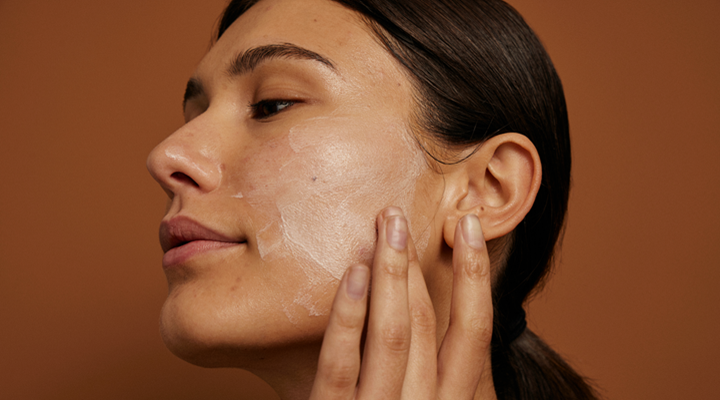CVS Pharmacy in the US did it. Cult Beauty in the UK also did it. Dove has championed it for years. Many big brands now stand behind using real skin in their advertising campaigns. Yes, it’s heartening to see brands stepping up and challenging the beauty industry’s status quo, and it’s a positive step towards promoting inclusivity and diversity in advertising. But what exactly does ‘real skin’ mean? And how are brands striking a balance between what is perceived as real and
and what is revered?
Recently, my friend Sam asked me why you never see acne in beauty adverts. “I thought brands wanted to be more real,” she pleaded with me. Ah, there is that word again – real. I started to explain that a significant component of the beauty industry relies on the premise of aspiration. People do not aspire to have imperfect skin. We have been conditioned to desire a flawless complexion.
Here’s an observation – when brands say they’re committed to using real skin in their advertising campaigns, they aren’t committing to using problematic skin, they’re committing to using unretouched skin in their ad campaigns. There’s a clear difference between the two.
Since the dawn of time, a clear complexion has been a sign of wealth. Why? Because the rich had access to beauty products that the poor could not afford. For a long time, only the wealthy could keep up with advancements in dermatology and cosmetic surgery. Of course, today this isn’t the case, as people from all walks of life seek out procedures to perfect their skin. But that doesn’t negate the fact that #RichGirlSkin has been trending and a flawless, poreless, dewy complexion is the ultimate goal for anyone with a mirror. Like it or not, clear skin is a status symbol.
It’s the reason celebrities like Hailey Bieber see great commercial success in launching beauty brands. Let’s be real, Hailey Bieber is genetically blessed with a flawless complexion. She’s also in her ’20s, so keep that in mind if you’re older and want to look more like the American model. Now, if Bieber had visible acne or severe rosacea, would her brand Rhode Skin be making millions? Probably not. I explain to Sam that the beauty industry will never succumb to the idea of imperfection, because imperfection doesn’t sell beauty products.
I recently spoke with well-known beauty photographer, Mette Kortelainen, who told me most of her clients “want to keep it natural when it comes to retouching”.
Kortelainen tells me things that get retouched are more likely to be a singular hair here and there, nails or the garment the model is wearing.
I asked how brands cast for their jobs. “It depends on the client,” she tells me. “Most of my clients use everyday-looking people instead of high-end models. People with acne, rosacea, or just faces that are not so polished. And then you have brands where an anti-retouching policy is part of the company values.”
When I look at Kortelainen’s photography, the models are clearly unretouched but they’re still incredibly aspirational. I cannot see any acne or rosacea in sight. It’s the perfect visual recipe for today’s beauty brands.
You see, certain visual qualifiers equate to an acceptable level of realism. Think of subtle stretch marks, freckles, a front tooth gap, greying hair and beauty spots. These are all physical attributes that make a campaign more relatable and, more importantly, keep the campaign aspirational. However, there is a fine line between authenticity and aspiration. For example, brands aren’t rushing to cast talent with cystic acne. Because their products aren’t selling cystic acne. The closest you’ll come to problematic skin in advertising is a before photograph, in anticipation of the flawless after.
So, when brands talk about using real skin in advertising, they’re talking about unretouched skin, not problematic skin. Personally, I like it that way. When I stand in the aisles of my favourite beauty retailers, I want to see unretouched, clear skin advertising the brand’s product range. If I didn’t, I would seriously question the efficacy of the product and decide to spend my money elsewhere. Remember, aspiration sells beauty products.
While we are making progress towards a more authentic visual definition of beauty, it is important to note the balance between authenticity and aspiration. If you’re planning your next photoshoot or working on the look and feel of a client’s brand, just remember – it’s this fine line that will continue to keep the industry running.
Further reading: Behind the push to phase out Photoshop and show “real skin” in beauty ads

